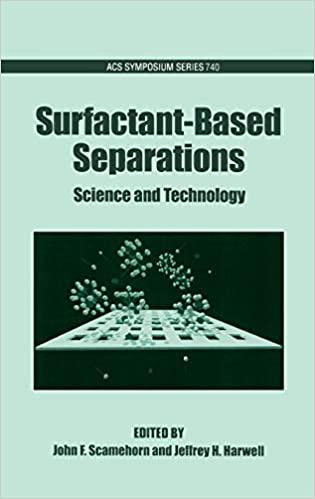$18.8 DIFFUSION IN A THREE-COMPONENT GAS SYSTEM Up to this point the systems we have discussed have been binary systems, or ones that could be approximated as two-component systems. To illustrate the setting up of multi- component diffusion problems for gases, we rework the initial evaporation problem of $18.2 when liquid water species 1) is evaporating into air, regarded as a binary mixture of nitrogen (2) and oxygen (3) at 1 atm and 352K. We take the air-water interface to be at 2- and the top end of the diffusion tube to beatz L. We consider the vapor pressure of water to be known, so that is known at 2 = 0 (that is, 1 - 341/760 = 0.449), and the mole fractions of all three gases are known atz-LL0.10, 12 = 0.75,14 -0.15. The diffusion tube has a length L. = 11.2 cm. The conservation of mass leads, as in 182, to the following expressions . - 1,2,3 (18.8-1) From this it may be concluded that the molar fluxes of the three species are all constants at steady state. Since species 2 and 3 are not moving, we conclude that N, and are both zero Next we need the expressions for the molar fluxes from Eq 17.9-1. Since x1 + 2 + 19 = 1, we need only two of the three available equations, and we select the equations for species 2 and 3. Since No - O and N, - , these equations simplify considerably: dr_N dry N I (18.8-2.3) Note that the diffusivity 9, does not appear here, because there is no relative motion of species 2 and 3. These equations can be integrated from an arbitrary heightz to the top of the tube at L, to give for constant N (18.8-4,5) Integration then gives NL-2) (18.8-6, 7) and the mole fraction profile of water vapor in the diffusion column will be N.CL- --- 1 - As expl Inex (18.8-8) When we apply the boundary condition at 2 - 0, we get NL expl (18.8-9) which is a transcendental equation for New cerpl - N.Q.-2) ty 568 Chapter 18 Concentration Distributions in Solids and in Laminat Flow According to Reid, Prausnitz, and Poling.' -0.364 cm/s and 9 -0.357 cm/s at 352K and 1 atm. At these conditions 346 x 10 g-moles/cm. To get a quick solu- tion to Eq. 18.8-9, we take both diffusivities to be equal to 0.36 cm/s. Then we get 0.449 - 1 - 09 expl N. (11.2) (18.8-10) 3.462 x 100.36) from which we find that N, -5523 x 10 g-moles/cm-s This can be used as a first guess in solving Eq. 18.8-9 more exactly, if desired. Then the entire profile can be calc lated from Eqs. 18.8-6 to 8 $18.8 DIFFUSION IN A THREE-COMPONENT GAS SYSTEM Up to this point the systems we have discussed have been binary systems, or ones that could be approximated as two-component systems. To illustrate the setting up of multi- component diffusion problems for gases, we rework the initial evaporation problem of $18.2 when liquid water species 1) is evaporating into air, regarded as a binary mixture of nitrogen (2) and oxygen (3) at 1 atm and 352K. We take the air-water interface to be at 2- and the top end of the diffusion tube to beatz L. We consider the vapor pressure of water to be known, so that is known at 2 = 0 (that is, 1 - 341/760 = 0.449), and the mole fractions of all three gases are known atz-LL0.10, 12 = 0.75,14 -0.15. The diffusion tube has a length L. = 11.2 cm. The conservation of mass leads, as in 182, to the following expressions . - 1,2,3 (18.8-1) From this it may be concluded that the molar fluxes of the three species are all constants at steady state. Since species 2 and 3 are not moving, we conclude that N, and are both zero Next we need the expressions for the molar fluxes from Eq 17.9-1. Since x1 + 2 + 19 = 1, we need only two of the three available equations, and we select the equations for species 2 and 3. Since No - O and N, - , these equations simplify considerably: dr_N dry N I (18.8-2.3) Note that the diffusivity 9, does not appear here, because there is no relative motion of species 2 and 3. These equations can be integrated from an arbitrary heightz to the top of the tube at L, to give for constant N (18.8-4,5) Integration then gives NL-2) (18.8-6, 7) and the mole fraction profile of water vapor in the diffusion column will be N.CL- --- 1 - As expl Inex (18.8-8) When we apply the boundary condition at 2 - 0, we get NL expl (18.8-9) which is a transcendental equation for New cerpl - N.Q.-2) ty 568 Chapter 18 Concentration Distributions in Solids and in Laminat Flow According to Reid, Prausnitz, and Poling.' -0.364 cm/s and 9 -0.357 cm/s at 352K and 1 atm. At these conditions 346 x 10 g-moles/cm. To get a quick solu- tion to Eq. 18.8-9, we take both diffusivities to be equal to 0.36 cm/s. Then we get 0.449 - 1 - 09 expl N. (11.2) (18.8-10) 3.462 x 100.36) from which we find that N, -5523 x 10 g-moles/cm-s This can be used as a first guess in solving Eq. 18.8-9 more exactly, if desired. Then the entire profile can be calc lated from Eqs. 18.8-6 to 8







